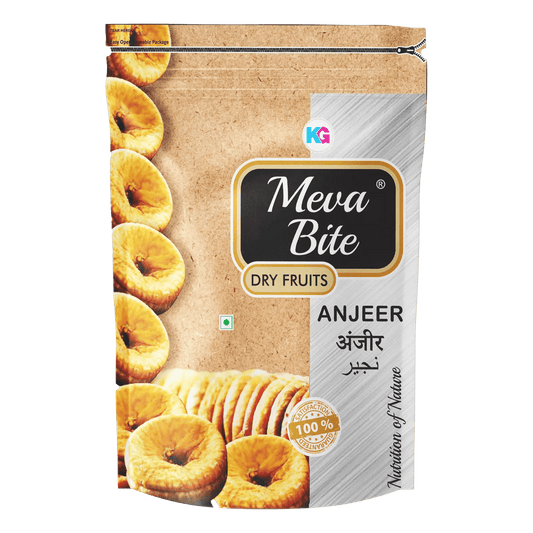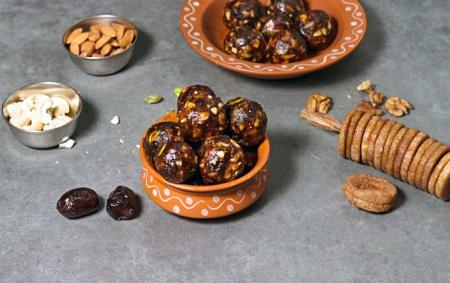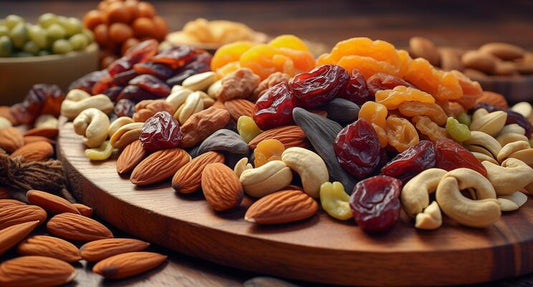How will the texture of different dried fruits change when soaked in milk?
Summary: Dried fruits soften when soaked in milk, with variations depending on the fruit type. Raisins become plump and juicy, while dates turn soft and creamy. Dried apricots and figs maintain some chewiness while absorbing milk.
Detailed explanation:
Raisins: Become plump and juicy, absorbing milk quicklyDates: Turn soft and creamy, melting in your mouth
Dried apricots: Soften while maintaining some chewiness
Figs: Absorb milk slowly, becoming tender but retaining texture
Dried cranberries: Plump up and become juicier, with a slight tartness
Prunes: Soften considerably, developing a velvety texture.
Will the sweetness of the dried fruit overpower the milk, or will it create a balanced flavor combination?
Summary: The combination of dried fruit and milk typically creates a balanced flavor profile. The milk's creaminess tempers the fruit's sweetness, resulting in a harmonious blend of flavors that complement each other.
Detailed explanation:
Natural fruit sugars infuse the milk, creating a subtly sweet flavor Milk's proteins and fats balance out the fruit's intense sweetness The combination offers a more complex taste than either component alone Adjusting the ratio of fruit to milk allows for personalized sweetness levels Some fruits, like tart cherries or cranberries, provide a contrasting flavor.Are there any specific flavor pairings of dried fruit and milk that work particularly well together?
Summary: Several dried fruit and milk pairings offer excellent flavor combinations. Popular choices include raisins with cinnamon-infused milk, dried apricots with almond milk, and dried figs with vanilla-flavored milk.
Detailed explanation:
Raisins and cinnamon milk: A classic combination with warm, comforting notesDried apricots and almond milk: Complementary nutty and fruity flavors
Dried figs and vanilla milk: Rich, sweet profile with aromatic undertones
Dried cranberries and coconut milk: Tart-sweet fruit balanced by creamy coconut
Dried mangoes and cardamom-spiced milk: Exotic blend of tropical and aromatic flavors
Dried cherries and chocolate milk: Indulgent combination reminiscent of Black Forest cake
Does soaking dried fruit in milk enhance its nutritional value in any way?
Summary: Soaking dried fruit in milk can enhance nutrient absorption, particularly calcium. The combination also provides a balanced mix of vitamins, minerals, and macronutrients from both the fruit and milk.
Detailed explanation:
Improved calcium absorption due to fruit's natural acids Enhanced vitamin D uptake when using fortified milk Increased bioavailability of iron from dried fruit Balanced protein intake from milk complementing fruit's carbohydrates Potential probiotic benefits when using fermented milk productsIs this a good snack option for both protein and healthy fats, or is it primarily for carbohydrates from the dried fruit and sugars?
Summary: Dried fruit with milk offers a balanced snack with carbohydrates, proteins, and healthy fats. While carbs from fruit dominate, milk contributes protein and fats, creating a more nutritionally complete option.
Detailed explanation:
Carbohydrates: Primarily from dried fruit, providing energy and fiberProteins: Milk contributes high-quality proteins for muscle health
Vitamins and minerals: Both components provide essential micronutrients
Balanced macronutrient profile: Helps with satiety and blood sugar regulation
Can adding dry fruit and milk be a more interesting and nutritious way to enjoy cereal in the morning?
Summary: Adding dried fruit and milk to cereal enhances both flavor and nutrition. It increases variety, adds natural sweetness, and boosts the overall nutrient content of the breakfast, making it more satisfying and enjoyable.
Detailed explanation:
Increases fiber content, promoting digestive health Adds natural sweetness, reducing the need for added sugars Enhances texture with chewy fruit pieces Boosts vitamin and mineral intake Improves protein content when combined with milk Creates a more satisfying and filling breakfast option.Do different types of milk (whole milk, skim milk, plant-based milk) work equally well with dried fruit?
Summary: Different milk types work well with dried fruit, each offering unique flavor profiles and nutritional benefits. Whole milk provides richness, skim milk offers a lighter option, and plant-based milks add variety and cater to dietary preferences.
Detailed explanation:
Whole milk: Rich and creamy, complements fruit flavors wellSkim milk: Lighter option, allows fruit flavors to dominate
Almond milk: Nutty flavor, pairs well with most dried fruits
Coconut milk: Tropical notes, excellent with exotic dried fruits
Soy milk: Neutral taste, good protein content
Oat milk: Creamy texture, works well with cereal combinations
How long should I soak the dried fruit in milk to achieve the desired texture and flavor?
Summary: Soaking times vary depending on the fruit and desired texture. Generally, 15-30 minutes is sufficient for most dried fruits, while overnight soaking works well for harder varieties or a softer texture.
Detailed explanation:
Raisins: 15-20 minutes for plump textureCan I add other healthy ingredients like nuts, seeds, or granola to make this a more complete snack or breakfast option?
Summary: Adding nuts, seeds, or granola to dried fruit and milk creates a more complete and nutritious meal. These additions provide extra protein, healthy fats, and fiber, enhancing both flavor and nutritional value.
Detailed explanation:
Nuts (almonds, walnuts, pistachios): Add crunch and healthy fatsSoaking dried fruit in milk might affect digestion for some people. Are there any tips to prevent any discomfort?
Summary: To prevent digestive discomfort when consuming dried fruit with milk, start with small portions, chew thoroughly, and consider lactose-free options if sensitive. Gradually increase intake to allow your digestive system to adjust.
Detailed explanation:
Start with small portions to gauge your tolerance Chew thoroughly to aid digestion Consider lactose-free milk if you're lactose intolerant Opt for plant-based milk alternatives if dairy causes issues Soak fruits for shorter periods to reduce sugar concentration Pair with digestive aids like ginger or peppermint tea if neededHow long can I store leftover soaked dried fruit and milk in the refrigerator before it spoils?
Summary: Leftover soaked dried fruit and milk can be stored in the refrigerator for up to 2-3 days. Ensure it's in an airtight container and check for any signs of spoilage before consuming.
Detailed explanation:
Store in an airtight container to prevent contamination Refrigerate immediately after preparation Consume within 2-3 days for best quality and safety Check for signs of spoilage (off-odor, mold, separation) before eating Stir well before consuming, as ingredients may settle Consider freezing portions for longer storage (up to 1 month)Conclusion
Combining dried fruit with milk offers a delicious and nutritious snack or breakfast option. This versatile combination provides a balance of carbohydrates, proteins, and healthy fats, along with essential vitamins and minerals. By experimenting with different types of dried fruits, milk varieties, and additional ingredients like nuts or seeds, you can create a personalized and satisfying meal. Remember to consider individual dietary needs and preferences, and always practice proper food safety when storing leftovers. Enjoy exploring the diverse flavors and textures of dried fruit with milk!














